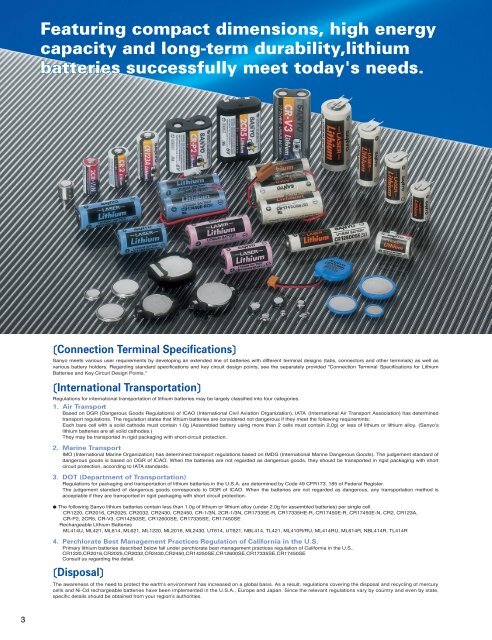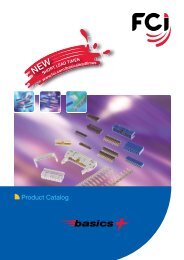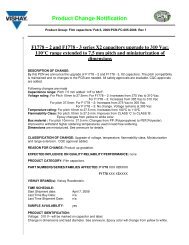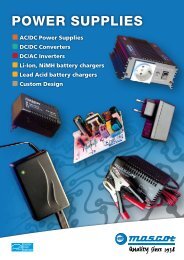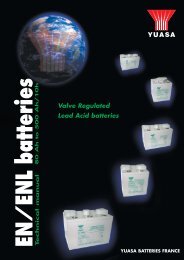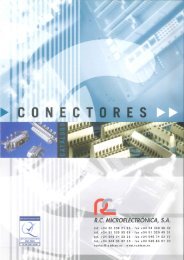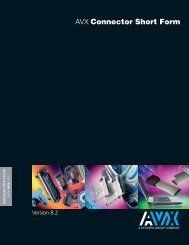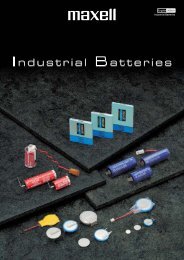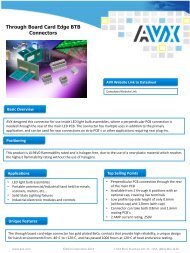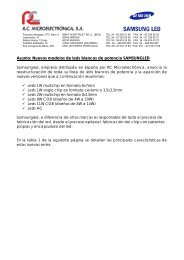Sanyo Lithium Batteries
Sanyo Lithium Batteries
Sanyo Lithium Batteries
You also want an ePaper? Increase the reach of your titles
YUMPU automatically turns print PDFs into web optimized ePapers that Google loves.
Featuring compact dimensions, high energy<br />
capacity and long-term durability,lithium<br />
batteries successfully meet today's needs.<br />
Connection Terminal Specifications<br />
<strong>Sanyo</strong> meets various user requirements by developing an extended line of batteries with different terminal designs (tabs, connectors and other terminals) as well as<br />
various battery holders. Regarding standard specifications and key circuit design points, see the separately provided "Connection Terminal Specifications for <strong>Lithium</strong><br />
<strong>Batteries</strong> and Key Circuit Design Points."<br />
International Transportation<br />
Regulations for international transportation of lithium batteries may be largely classified into four categories.<br />
1. Air Transport<br />
Based on DGR (Dangerous Goods Regulations) of ICAO (International Civil Aviation Organization), IATA (International Air Transport Association) has determined<br />
transport regulations. The regulation states that lithium batteries are considered not dangerous if they meet the following requiremints:<br />
Each bare cell with a solid cathode must contain 1.0g (Assembled battery using more than 2 cells must contain 2.0g) or less of lithium or lithium alloy. (<strong>Sanyo</strong>’s<br />
lithium batteries are all solid cathodes.)<br />
They may be transported in rigid packaging with short-circuit protection.<br />
2. Marine Transport<br />
IMO (International Marine Organization) has determined transport regulations based on IMDG (International Marine Dangerous Goods). The judgement standard of<br />
dangerous goods is based on DGR of ICAO. When the batteries are not regarded as dangerous goods, they should be transported in rigid packaging with short<br />
circuit protection, according to IATA standards.<br />
3.<br />
DOT (Department of Transportation)<br />
Regulations for packaging and transportation of lithium batteries in the U.S.A. are determined by Code 49 CFR173. 185 of Federal Register.<br />
The judgement standard of dangerous goods corresponds to DGR of ICAO. When the batteries are not regarded as dangerous, any transportation method is<br />
acceptable if they are transported in rigid packaging with short circuit protection.<br />
The following <strong>Sanyo</strong> lithium batteries contain less than 1.0g of lithium or lithium alloy (under 2.0g for assembled batteries) per single cell.<br />
CR1220, CR2016, CR2025, CR2032, CR2430, CR2450, CR-1/3N, 2CR-1/3N, CR17335E-R, CR17335HE-R, CR17450E-R, CR17450E-N, CR2, CR123A,<br />
CR-P2, 2CR5, CR-V3, CR14250SE, CR12600SE, CR17335SE, CR17450SE<br />
Rechargeable <strong>Lithium</strong> <strong>Batteries</strong><br />
ML414U, ML421, ML614, ML621, ML1220, ML2016, ML2430, UT614, UT621, NBL414, TL421, ML410R/RU, ML414RU, ML614R, NBL414R, TL414R<br />
4. Perchlorate Best Management Practices Regulation of California in the U.S.<br />
Primary lithium batteries described below fall under perchlorate best management practices regulation of California in the U.S..<br />
CR1220,CR2016,CR2025,CR2032,CR2430,CR2450,CR14250SE,CR12600SE,CR17335SE,CR17450SE<br />
Consult us regarding the detail.<br />
Disposal


